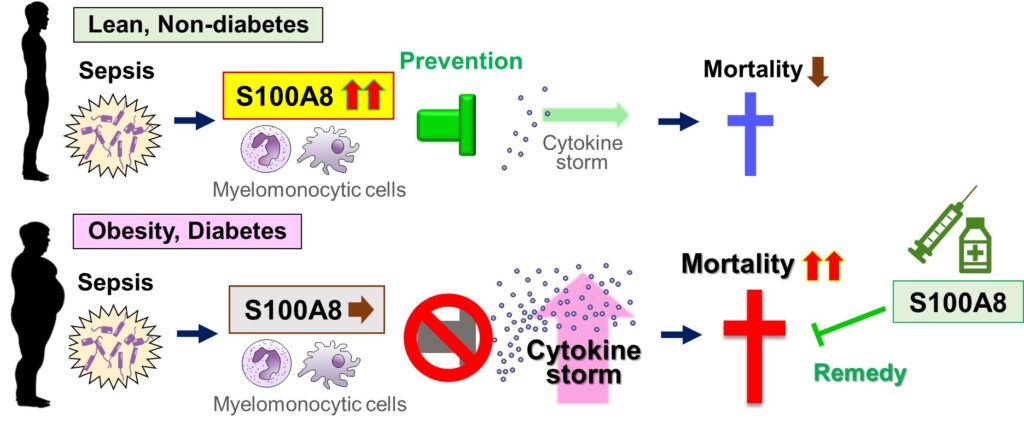Daisuke Miyashita,1,2,# Ryota Inoue,1,2,# Takahiro Tsuno,1,2 Tomoko Okuyama,2 Mayu Kyohara,2 Chigusa Nakahashi-Oda,3 Kuniyuki Nishiyama,1,2 Setsuko Fukushima,1 Yutaro Inada,2 Yu Togashi,2 Akira Shibuya,3 Yasuo Terauchi, 2 and Jun Shirakawa1,2,* (1. Laboratory of Diabetes and Metabolic Disorders, Institute for Molecular and Cellular Regulation (IMCR), Gunma University, Japan; 2. Department of Endocrinology and Metabolism, Graduate School of Medicine, Yokohama City University, Yokohama, Japan; 3. Department of Immunology, Faculty of Medicine, University of Tsukuba, Tsukuba, Japan; #: co-first author, *: Corresponding Author)
About
Obesity and diabetes are independent risk factors for death during sepsis. S100A8, an alarmin, is related to inflammation, obesity, and diabetes. Here, we examine the role of S100A8 in sepsis of obesity and diabetes models. Injection of S100A8 prolong the survival of septic mice induced by lethal endotoxemia, Escherichia coli injection, or cecal ligation and puncture. S100A8 decrease the LPS-induced expression of proinflammatory cytokines in peritoneal macrophages by inhibiting TLR4-mediated signals in an autocrine manner. db/db, ob/ob, and western diet-fed mice demonstrate reduced upregulation of S100A8 induced by LPS treatment in both serum and peritoneal cells. These mice also show shorter survival after LPS injection, and S100A8 supplementation prolonged the survival. While myelomonocytic cells-specific S100A8-deficient mice (Lyz2cre:S100A8floxed/floxed) exhibit shorter survival after LPS treatment, S100A8 supplementation prolonged the survival. Thus, myelomonocytic cell-derived S100A8 is crucial for protection from sepsis, and S100A8 supplementation improve sepsis, particularly in mice with obesity and diabetes.
Paper information
Protective effects of S100A8 on sepsis mortality: links to sepsis risk in obesity and diabetes.
Daisuke Miyashita, Ryota Inoue, Takahiro Tsuno, Tomoko Okuyama, Mayu Kyohara, Chigusa Nakahashi-Oda, Kuniyuki Nishiyama, Setsuko Fukushima, Yutaro Inada, Yu Togashi, Akira Shibuya, Yasuo Terauchi, and Jun Shirakawa*
iScience. 105662, 2022. DOI:https://doi.org/10.1016/j.isci.2022.105662
Online URL
https://www.cell.com/iscience/fulltext/S2589-0042(22)01934-4








